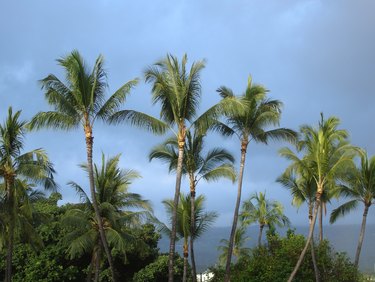
Swaying gently in the soft ocean breeze or bouncing back and forth like an elastic rubber band in a hurricane, the palm tree (family Arecaceae) is one of the most resilient trees found in subtropical climates.
As ideal landscape trees, both queen (Syagrus romanzoffiana) and king palms (Archontophoenix cunninghamiana) are perennials in U.S. Department of Agriculture plant hardiness zones 10 and 11 and present a royal welcome as they line the boulevards of cities and towns. The differences between queen and king palm trees can be found in their fronds, trunks and flowers.
Video of the Day
Video of the Day
Tip
The palm fronds indicate which is king and which is queen. King palm fronds grow from a bright green crown shaft while queen palms do not have a crown shaft.
Queen Palm Characteristics
Flowing from the lower branches of the queen palm, like Rapunzel's golden locks, a mass of yellow flax identifies the tree as a queen palm. These are the seed structures, and, unless trimmed in the spring and early summer, they turn into bright orange berries that are often considered a mess to clean and attractive to pests. Quill-like fronds develop from the stalk.
Native to South America, the queen palm reaches a mature height of 50 feet with a trunk that's usually straight, and a head crowned with fronds that first grow upward before spilling down. If the trunk bends toward the ground, the culprit is its shallow root system at the mercy of heavy winds. Its smooth grey trunk shows the scars of previous growth. Often propped up with "boots" that stabilize the tree as it acclimatizes to its environment, the queen palm is ideal for home landscapes and waterside venues, where the scenery can be viewed through its well-spaced green, shiny fronds.
King Palm Characteristics
Native to Australia's southern states, the monarch of all palm trees, the king palm comes to its name due to its regal presence. Growing to heights of up to 70 feet, the king is crowned with a shock of green fronds, each growing up to 10 feet in length. Flower-bearing stems originate at the base of the frond splays and produce pink-orange berries that ripen to red in the fall. Its multi-colored trunk distinguishes it from the queen palm and adds to its visual appeal, according to the San Diego Union-Tribune.
King palms are what is known as "self-cleaning" in that new fronds are housed within the crown shaft, just above the top of the tree. As new fronds emerge, the old ones are pushed aside and eventually fall. The tree is also highly wind-tolerant and rarely folds during heavy winds. In the right growing conditions, the king palm can grow up to 24 inches a year. It is also susceptible to mealy bugs and spider mites and suffers pink rot when the tree is damaged.
Maintaining Palm Trees
While king palms clean themselves of old fronds, the queen palm requires more maintenance. Both palms can suffer from nutrient deficiencies if not planted on acidic soil. They also like moist soil and dislike other plants growing close to the base.
The queen palm is a pollen hazard, and frizzy fronds develop without proper nutrition. The weak root system makes it one of the few palms that topple over during a hurricane. Feeding them with palm fertilizer adds the nutrients the tree needs.